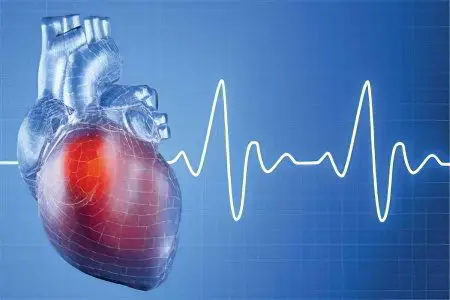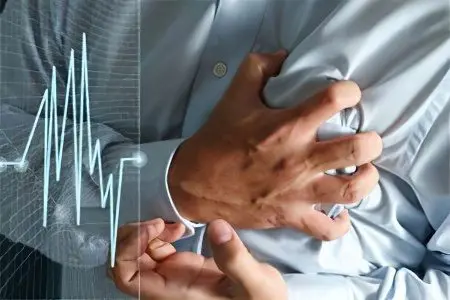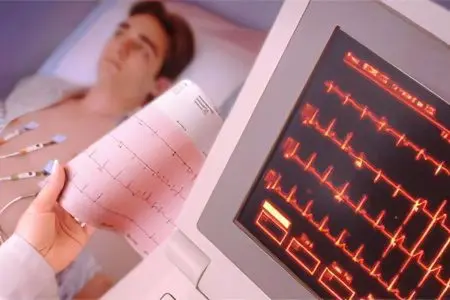Contents
- Myocardial infarction – what is it?
- Myocardial infarction mortality statistics
- Causes of myocardial infarction
- The first signs of a heart attack in men and women
- The main symptoms of myocardial infarction
- Consequences of myocardial infarction
- Diagnosis of myocardial infarction
- First aid for a heart attack
- Recovery and rehabilitation after a heart attack
- Prevention of heart attack
Myocardial infarction – what is it?
Myocardial infarction is a focus of ischemic necrosis of the heart muscle, which is formed due to an acute violation of the coronary circulation. This condition poses a direct threat to life, therefore, it requires emergency hospitalization of a person in the intensive care unit of the cardiology department. If timely assistance is not provided, then the pathological process most often ends in death.
The term was first introduced in 1896 by R. Marie, and the clinical picture of the disease was described in 1892 by V. M. Kerning.
Statistics indicate that a heart attack between the ages of 40 and 60 occurs in men 3-5 times more often than in women, and is caused by existing atherosclerosis. Starting from 55 to 60 years, it is recorded in both sexes with approximately the same frequency. In young and middle-aged women, an acute heart attack develops less frequently than men, experts attribute this to the fact that female sex hormones delay the development of atherosclerosis. After the end of menopause, the level of estrogen in the female body drops sharply and a heart attack occurs even more often than in men. In addition, the consequences for women from an acute myocardial infarction are more global and often lead to death.
This cardiovascular pathology mainly affects the population living in industrialized countries, in large cities.
If the blood circulation of the myocardium remains impaired for more than 20 minutes in a row, then this leads to the formation of irreversible changes in the heart muscle, as well as to a pronounced disorder in the functioning of the heart. Part of the muscle cells undergoes necrosis, being replaced by connective tissue fibers. As a result, a post-infarction scar on the heart is formed in a person who has had a heart attack. Naturally, this will negatively affect the further work of the body.
Myocardial infarction mortality statistics

Death from myocardial infarction is recorded in 30-35% of cases. Moreover, from 15 to 20% of all sudden deaths are due to this pathology. Statistics indicate that in the United States alone, 140 people die from a heart attack every day.
There is also evidence that of all deaths from a heart attack, 52% are women, and 48% are men.
At the prehospital stage, death occurs in about 20% of cases, another 15% of patients die in the hospital. The maximum mortality rate of patients is recorded in the first two days, so it is so important to carry out competent therapeutic actions in this short period. It was experimentally confirmed that if perfusion is restored within 4-6 hours from the onset of the pathological process, then the size of the scar is not so large, the local and general contractility of the left ventricle improves significantly, and the risk of post-infarction complications decreases. The restoration of perfusion during the first 60-120 minutes from the onset of an acute infarction has a particularly good effect on the condition of patients.
Causes of myocardial infarction
The etiology of this disease can be very diverse, however, in 95% of cases, myocardial infarction is the result of thrombotic occlusion of arteries that have undergone atherosclerotic changes. In this case, the infarction is an acute form of cardiac ischemia. The formation of blood clots is promoted by high blood viscosity in patients with ischemia.
In all other cases, a heart attack becomes a complication of other diseases and pathologies, including:
Malformations of the coronary arteries;
Blockage of arteries by fragments of a parietal thrombus, a thrombus from a parietal valve, parts of a tumor, vegetations;
Any inflammation of the vessels responsible for the nutrition of the heart muscle – narrowing of the arteries, their rupture, Buerger’s disease, aortic aneurysm, disturbances in the functioning of the vascular endothelium;
DIC syndrome, accompanied by the formation of a blood clot in the coronary artery. Factors such as a decrease in the volume of circulating blood, infections, poisoning of the body, malignant tumors, thrombocytosis, chronic leukemia, etc. are capable of provoking DIC;
Tumor of the heart. A heart attack occurs due to its necrosis, or due to blockage of the coronary artery by parts of a growing neoplasm;
Extracardiac tumors lead to infarction when they grow and metastasize to the artery;
A heart attack can be provoked by electric shock, mechanical trauma, as well as damage to the arteries and heart during cardiac surgery;
A heart attack can develop against a background of spasm of the coronary arteries due to the use of narcotic substances (amphetamine, cocaine);
Hypertension, diabetes mellitus, obesity, alcohol abuse, smoking, nervous and physical stress – all these factors in the presence of cardiac ischemia can cause a heart attack.
The first signs of a heart attack in men and women

The initial manifestations of a heart attack in men and women are somewhat different. It is found that its symptoms in women are more blurred. Only 43% of patients note the sudden development of pathology, in all other cases it is preceded by a period of unstable angina pectoris of varying length with pain at rest.
The first signs of a heart attack in women may resemble the flu or severe overwork. In this regard, doctors often underestimate the severity of the patient’s condition and recommend her home treatment with bed rest. At the same time, 95% of women who had a heart attack indicated that they had manifested health problems long before the crisis.
On average, the pre-infarction period is a month, at which time the following symptoms are observed:
Increased fatigue was noticed by up to 70,7% of women. It is characteristic that fatigue does not go away after a night’s rest. Patients feel overwhelmed and exhausted, they lack the strength to perform daily activities. Over time, the condition does not improve and goes into constant weakness;
Sleep problems (up to 47,8%). Women hardly fall asleep, often wake up at night;
Labored breathing. Even with a slight load, the patient develops shortness of breath. After rest, breathing returns to normal;
Pain and discomfort in the chest (29,7%), which resemble pain that occurs when the muscles of the sternum are stretched. Possible irradiation of pain in the shoulder, upper jaw, arm, neck. Sometimes the limbs go numb and tingle;
Probably the development of a headache, disorders of the organs of vision;
Characterized by mood swings, unreasonable anxiety;
Digestion is disturbed, heartburn, nausea, and sometimes vomiting occur;
The skin is paler than usual, cold sweat often occurs.
These statistics of the first signs of a heart attack in women are given by the authors of an article published in the journal Circulation in 2003. The survey involved 515 women who had already suffered a heart attack. They indicate that its first signs are passing: they appear, then disappear again. Women notice them, but they are in no hurry to see a doctor because of a sense of embarrassment and fear. They compare their condition with a cold or flu, in which there is also increased fatigue, weakness, weakness.
As for men, their first sign of a heart attack is chest pain. They indicate that they had no early signs. Of course, this is not really the case. The body always gives certain signals that something is wrong with it, but men simply ignore them. During the heart attack itself, 43% of women did not experience pain at all, while this pathology proceeds painlessly in only 10% of men. Breathing problems were reported by 57% of the women surveyed.
The main symptoms of myocardial infarction

The main symptoms of myocardial infarction depend on whether it is typical or atypical.
A typical case is characterized by the following clinical picture:
The first period of a heart attack is called “acute”. It is characterized by extremely intense pain, which is localized mainly in the chest. They can give to the neck, to the teeth, to the left shoulder or collarbone, to the area between the shoulder blades, to the ear;
The pains are different. They can be pressing, bursting, sharp. The larger the area of the myocardium is affected, the stronger the pain;
Attacks of pain have a wave-like character, becoming either stronger or weaker. The duration of the attack is different – from half an hour to several hours or even days. Secondary intake of Nitroglycerin does not relieve pain;
The patient experiences a strong sense of fear, may be overly excited. Sometimes attacks of pain, on the contrary, are accompanied by apathy, weakness and shortness of breath;
The skin turns pale, cold sticky sweat appears;
Blood pressure during an attack rises, and then either moderately or drops sharply. In parallel, the patient develops tachycardia and arrhythmia;
The gradual fading of pain characterizes the completion of the acute period of a heart attack and the beginning of an acute period. At this time, pain can persist only if the patient develops pericarditis or the near-infarction zone is exposed to severe ischemia;
The patient’s body temperature rises, which is due to the start of the processes of necrosis and perifocal inflammation. The fever can last up to 10 days or more. The larger the affected area, the higher the body temperature will be, and the longer it will last. In parallel, symptoms of heart failure and arterial hypotension will increase;
If the patient survives the acute period of a heart attack, then a subacute period follows with normalization of body temperature, with the elimination of pain and with an improvement in general well-being. Symptoms of heart failure go away.
In the postinfarction period, all indicators of the patient’s health return to a relative norm.
It is worth considering the fact that the symptoms of a heart attack in men are most often clear. The male sex is characterized by the classical development of a heart attack. The predominant symptom is chest pain. In women, a heart attack in the vast majority of cases proceeds blurry. Symptoms are similar to those of the flu, or severe overwork.
Of course, in the most acute period of a heart attack, women experience chest pains, but usually they are not as intense as in men. The pain spreads throughout the sternum, not localized in the region of the heart. Characterized by dizziness, cold sweat, nausea, shortness of breath.
As already mentioned, a heart attack can occur atypically, the symptoms of which are observed in 70-90% of cases.
However, other variants of pathogenesis are not excluded, among which:
Asthmatic variant of the development of an attack. During its onset, shortness of breath and suffocation come to the fore, the heartbeat quickens. Pain is either absent altogether or mild. The frequency of occurrence of an asthmatic variant of a heart attack is 10%. This course is typical either for the elderly, or for those patients who suffer a second attack;
Gastralgic variant of the development of an attack. Pain is localized at the top of the abdomen, accompanied by hiccups, belching, nausea, repeated vomiting. Abdominal bloating is characteristic, and diarrhea can sometimes develop. Pain is given in the back, in the shoulder blades. The incidence of gastralgic variant of infarction is 5%. This course of the attack is observed in patients with lower myocardial infarction;
Arrhythmic variant of the development of an attack. In this case, the violation of the heartbeat comes to the fore. The pains are not expressed, the person, as a rule, does not pay attention to them. During an attack, weakness is observed, some patients experience shortness of breath. The frequency of occurrence of an arrhythmic variant of a heart attack varies from 1 to 5%;
Cerebrovascular variant of the development of an attack. The patient is disoriented in space, feels dizzy, may lose consciousness, sometimes vomiting occurs. Neurological symptoms often lubricate the clinical picture of a heart attack, and it can only be determined by the results of an ECG. The frequency of occurrence of the cerebrovascular variant of the development of an attack varies from 5 to 10% and increases with age;
An asymptomatic variant of the development of an attack. Often, a previous heart attack is discovered by chance during an ECG. At the same time, a survey of patients shows that almost 90% of them noted inexplicable weakness, deterioration in well-being and mood, chest pain, and shortness of breath. But these symptoms did not make them see a doctor. The frequency of occurrence of an asymptomatic variant of the development of an attack varies between 0,5-20%. Most often, such attacks occur in people with diabetes.
It should be noted that only the most acute period of a heart attack proceeds atypically, all subsequent periods are characterized by a monotonous clinical picture.
Consequences of myocardial infarction

The consequences of myocardial infarction can often be detected already in the first few hours after its manifestation. They significantly worsen the course of the pathology and negatively affect the health of the patient.
During the first 3 days, various arrhythmias most often develop: flickering is the most formidable consequence of a heart attack, it often turns into ventricular fibrillation and leads to death. It has been established that cardiac conduction disturbances and disruptions in its rhythm occur in 40% of patients in the late period. As for the early period, heart rhythm disturbances are recorded in 100% of patients.
Left ventricular heart failure is expressed in symptoms of cardiac asthma, in congestive wheezing, and pulmonary edema may develop. The most serious consequence of left ventricular failure is cardiogenic shock, which most often leads to death. In this case, systolic pressure falls below 80 mm Hg. Art., the person loses consciousness, tachycardia and cyanosis are observed. It was found that acute heart failure in the early period develops in 50% of patients.
If in the zone of necrosis caused by a heart attack, a rupture of muscle fibers occurs, this often leads to an outflow of blood into the pericardial cavity. This complication is called cardiac tamponade.
In 2-3% of cases, patients have a clot blockage of the pulmonary artery or systemic circulation. This is the most dangerous complication, which most often leads to the sudden death of a person.
In 8% of cases, the development of an acute mental disorder is possible.
Sometimes patients develop acute ulcers of the stomach and intestines. This happens in 3-5% of cases.
Acute aneurysm of the heart. If it turns into a chronic aneurysm, then most likely the patient will develop heart failure. Chronic heart failure develops in 12-15% of cases.
An extensive heart attack is dangerous with a rupture of the ventricle due to an acute cessation of blood circulation. Especially high is the risk of rupture of the ventricle in the first 10 days after the attack.
Upon completion of the acute phase of infarction, patients often experience fibrin deposition on the walls of the endocardium. This further leads to the formation of a parietal thrombus. Its detached parts can cause embolism of the pulmonary, cerebral, and renal vessels. Thromboembolic complications are recorded in 5-7% of cases.
A late complication of a heart attack is Dressler’s post-infarction syndrome. It is expressed in arthralgia, pleurisy, fever, pericarditis and eosinophilia. The syndrome develops in 1-3% of cases and is associated with the body’s immune response to the formation of a necrosis zone.
Diagnosis of myocardial infarction

Diagnosis of myocardial infarction is built on ECG data, on the collection of anamnesis and the study of indicators of the activity of blood serum enzymes:
Questioning the patient. The patient’s complaints depend on what form of infarction he has – typical or atypical, as well as on how extensive the zone of damage to the heart muscle is. The doctor is obliged to suspect a heart attack in the case when a person has retrosternal pain for half an hour or more.
ECG. On the ECG during a heart attack, a negative T-wave, or a Q-wave, or a pathological QRS complex is formed.
Blood test. Depending on the time after the onset of an attack in the blood, an increase in four indicators is detected:
For the first 4-6 hours after a painful attack has manifested, an increased amount of myoglobin, which is responsible for supplying oxygen to cells, is found in the human blood.
After 8-10 hours from the onset of an attack in the blood, the level of creatine phosphokinase increases by half. This indicator will return to normal only after 48 hours. If there are 3 negative results for creatine phosphokinase, then infarction is ruled out.
After 24-48 hours from the onset of an attack, to confirm a heart attack, a test is performed to determine the enzyme lactate dehydrogenase, the level of which rises precisely at these times. This indicator will return to normal only after 1-2 weeks.
In addition, the ESR, the level of leukocytes, AsAt and AlAt in the blood increases.
Echocardiography allows you to determine violations of contractility of the ventricle, as well as thinning of its wall.
Coronography reveals thrombotic occlusion of the coronary artery, decreased ventricular contractility. In addition, this study provides information regarding the possibility of performing angioplasty or coronary artery bypass grafting.
Troponin test for myocardial infarction
Troponin test in myocardial infarction is a highly specific diagnostic method that allows you to determine the increase in the number of myocardial troponin protein isoforms in the blood. The level of troponin-1 and troponin-T increases significantly 3-4 hours after the attack, which makes it possible to speak with confidence about myocardial infarction. Troponins will remain in the blood at a high level for another two weeks. Therefore, even if a person, for some reason, did not end up in a medical facility, the opportunity to determine his past heart attack still remains.
Modern medicine considers the troponin test as an integral part of the diagnosis of myocardial infarction. Its undoubted advantage is the fact that it allows you to determine even a slight damage to the muscles of the myocardium.
First aid for a heart attack
First aid for a heart attack should be provided immediately.
It is important to call an ambulance as soon as possible, and before it arrives, follow the following algorithm of actions:
The patient should assume a sitting position. To do this, you can put pillows under his head;
To ensure air access, it is necessary to unbutton the collar of the shirt, remove all accessories (scarves, ties, etc.) that pull it from the neck;
Under the tongue, a person needs to put a Nitroglycerin tablet, or spray one dose of this remedy into his mouth, if it is at hand in the form of a spray. If Nitroglycerin is taken for the first time, then the dose should be reduced by half;
Repeat the intake of Nitroglycerin every 5 minutes. The maximum number of receptions is 3 times;
In addition to Nitroglycerin, the victim can be given half a tablet of Aspirin and Plavix;
If the ambulance is delayed, then you can give the patient an injection of Analgin or Baralgin, which will reduce pain.
These are all actions that a person without medical education can perform to help a patient with a heart attack.
Recovery and rehabilitation after a heart attack

Rehabilitation of a patient after a heart attack is a whole range of measures that are aimed at treating the disease, as well as preventing its complications. Properly built therapy allows you to restore the physical activity of a person, correct possible psychological disorders and return him to work.
The patient should gradually restore the lost physical activity. On the first day after a heart attack, strict bed rest is indicated with the patient in the intensive care unit. Doctors are required to constantly monitor all vital signs. If complications of a heart attack do not develop, then on the second day the patient is allowed to sit down and rise in bed. At the same time, you can begin to perform therapeutic exercises under strict monitoring of pulse and pressure.
On the fourth day, the patient is transferred to the general ward, and he can begin to use the common toilet. The patient is discharged on the 16-21st day, before that he is tested with a dosed physical activity. It allows you to assess the readiness of the body to move and to suggest the risk of developing myocardial ischemia and other delayed complications. If this risk is high, then the timing of the activation of the patient is postponed. Further rehabilitation is carried out in cardiological sanatoriums.
Most people who have had a heart attack require the help of a psychologist or psychiatrist. The fact is that mental disorders are observed in 30% of such patients. These disorders are expressed in a tendency to depression, insomnia and increased anxiety. From 1 to 5% of patients suffer acute psychoses. At the discretion of the doctor, such patients are prescribed antidepressants, hypnotics and sedatives.
Without fail, the patient is consulted before discharge with a view to his possible return to work, as well as about what mode of physical activity he should adhere to.
After discharge from the hospital, patients must follow a certain diet, take medications, and exercise.
Diet. It is important that the meals the patient receives are low in cholesterol and saturated fat. Every day, fresh vegetables (preferably green) and fruits should be included in the menu. It is better to replace animal meat with poultry and fish, and butter and margarine with olive oil.
Physical exercise. For people in the post-infarction period, special programs have been created that allow you to dose physical activity, contribute to accelerated social and psychological adaptation. Initial training should take place under the strict supervision of doctors, then you can start doing exercises at home. In each case, the volume of loads is determined individually after the patient passes the test with dosed physical activity. Exercises on simulators, on bicycle paths, in the pool are useful. Training should be done at least three times a week.
Taking medicines
All people who have had a myocardial infarction should receive medical therapy.
Recommended medicines include:
lipid-lowering drugs. So, taking Simvastatin, Atorvastatin, Pravastatin can reduce the risk of a second heart attack. It has been established that statins can reduce the number of deaths from such complications of a heart attack as unstable angina, cardiosclerosis, exertional angina;
Antiplatelet agents. Continuous use of Aspirin can reduce the risk of developing cardiovascular complications by 25%. Replacement of aspirin are drugs such as Clopidogrel, Ticlodipine;
The presence of symptoms of heart failure requires the use of ACE inhibitors. The patient is given these drugs even in the acute period of a heart attack, then the dose is adjusted;
Beta-blockers reduce the risk of sudden death after a heart attack by 32%, and also reduce overall mortality by 23%. These can be drugs such as Timolol, Metoprolol, Bisoprolol, etc.
Prevention of heart attack
Prevention of a heart attack is reduced to the following actions:
Daily blood pressure monitoring;
Control of cholesterol and blood sugar levels;
Absence of bad habits;
Proper nutrition with the rejection of fried, fatty smoked and canned foods. Reducing the amount of salt consumed;
Increased physical activity;
Avoidance of stressful situations;
Timely and adequate treatment of all diseases associated with the heart and blood vessels.
Myocardial infarction is a formidable disease, but maintaining a healthy lifestyle can significantly reduce the risk of its development.
[Video] Dr. Berg – PREVENTION OF HEART DISEASE. How to avoid a heart attack?









